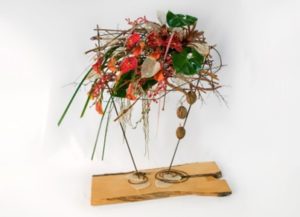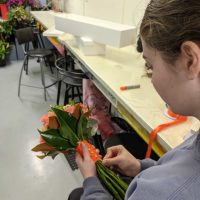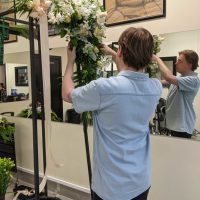THE NEED FOR FLORISTRY TRAINING IN PARTICULAR IN-SHOP TRAINING
Florists are often surprised to hear about the rigorous internal training regimes used by many businesses in comparable industries. These businesses maximise the value of their staffing cost by incorporating methods of ‘upselling’ into the staff training process, to encourage staff to achieve the best results possible in meeting the needs of the business. Product knowledge, skill, and speed combined with accuracy are all taught and promoted. Employers of apprentices (school-based apprentices) fuse their training with that delivered by registered training providers (RTOs). While an RTO is bound by the National Floristry Training Package, SFL10, and its requirement to provide broad-based industry training. Most often apprenticeship is Certificate III in Floristry SFL30110 in Australia. However, in-house training provides additional advantages in that it is site-specific and targets the unique needs of the business and its client base.
In floristry, in-house training forces senior florists to re-examine their skill level and performance. This is a highly beneficial part of the process, because new staff members will mirror the skill level of the florist training them. Sometimes florists become ‘matter of fact’ about taking orders and selling, and they can lose the passion and drive that are so important for making successful sales. For this reason, a review of their own processes is a great starting point.
Anticipating potential problems
Often a florist will show a new staff member an order form, ask them to look at the headings, and then tell them just to ‘have a go’. This is actually quite common. However, why subject the client to such inexperience? Consider the potential consequences of a lack of training and the major problems it could cause to the business and to client confidence.
For example, think about the cost to the florist associated with a non-delivery. Courier companies charge a fee to deliver the flowers, and if the recipient is not at the hospital, office or home, there is a charge to return the flowers to the florist and a further charge to re-deliver. While such situations do happen and may be understandable, they can be difficult to explain to a frustrated client.
Scenarios resulting from poor training that might cause problems or non-delivery might include the following:
- The florist assumes that a hospital order is for a patient, but it is actually for a member of the hospital staff. This could result in a non-delivery, as the recipient is not on the patient list. Even if the recipient is known to be a staff member, they may not be on the staff list if they are employed in a temporary capacity.
- The driver arrives at the hospital but is uncertain whether the patient is in the maternity or general ward.
- The recipient is a day patient and has already been discharged.
- The gender of a new baby is not determined when taking the order. Due to privacy restrictions, the hospital will be unable to advise the florist.
- The delivery address is in a remote area and sufficient details are not recorded. The customer might say, “Everyone knows them”. Everyone perhaps, except for the florist and the driver! Remember, a country road can be twenty kilometres long and without a clear description, the driver wastes time and money.
- The property has a security fence and no-one is home to provide access.
- An apartment has a security entrance and no-one is at home. The driver tries other apartments, but no-one is home there either. As a result, the flowers cannot be left safely.
- A corporate address does not list the name of the firm, the floor, the department or the extension number. The recipient could also be a temporary staff member and not on the list.
- Funeral flowers are required for a casket, but are not correctly labelled as the florist did not ask. As a result, the flowers are not placed on the casket and the client makes a severe complaint.
- Insufficient details are collected by the florist regarding other aspects of a funeral flower order. For example: Should the flowers be sent to a church or a parlour? What are the expectations and procedures of the venue? How and where should the deceased be referred to on the card?
- The florist takes an order but forgets to take the client’s contact phone numbers. The credit card is declined, but the florist cannot contact the client. Do they send the order or not? If the numbers were not repeated and checked carefully when the order was taken, it could be the florist’s fault and then you will have a very angry client if the flowers are not delivered.
- A new staff member takes a pick-up order and fails to record the client’s phone number. The order is made, but is not collected by the client. In this case, the result is an unhappy employer and a loss of revenue.
These are some of the broad areas and potential scenarios in which a lack of training could damage a business. I’m sure there are many other specific examples you can think of, depending on the various types of orders, clients and workplace situations.
Although the consequences of such problems can be dire for a business, the good news is that there are certain training strategies which can make a big difference. For example, to reduce the likelihood of issues associated with deliveries, it is a good idea for a newer staff member to spend at least one day with the driver. I can assure you, after this first-hand experience, they will be more precise with the questions they ask and the details they record. To prevent problems with credit cards or pick-up orders, a florist should have clear procedures in place regarding the types of details that are collected and the way they are recorded. In these relatively simple ways, the well-considered in-house training of staff can improve the efficiency and bottom line of the business.
Selling skills
After training has been done in operational areas such as details and deliveries, the most important area to focus on is in the actual selling of the products and services, and also in recognising opportunities to ‘up sell’.
Most florists’ websites feature prices, but only some suggest occasion. How many florists are missing the opportunity to suggest to the customer the occasions and uses for which an item might be suitable? It is a great selling tool, as it guides the client but allows them to ultimately make their own choice.
It is always best to take down the card wording on a phone order before you commence selling. This allows the florist to determine the purpose of the purchase and the closeness of the client to the recipient. If the card is to read, “All my love darling, John”, it indicates an important need or special occasion. So, take the lead, and sell up. Suggest the prestige or premier range for the client. Establish upselling as a routine procedure in the business, and ensure that it is taught to newer staff members. In this way, the business will not only become more profitable, but it will also ensure that the customers always get what they need. I find that it is not uncommon for florists to ask a client what they want to spend. But this is a counter-productive approach to selling. I don’t know about you, but I would be surprised if I walked into a butcher or bakery store to be asked, “What do you want to spend”? It is actually a case of what you need to spend, to obtain the item required.
The informed and uninformed client
The uninformed client will be guided by you. Assist them to the best choice. Suggest that they leave the flower and colour selection to the florist, unless there is a specific request. Tell them the approximate size of the final item and practice how you describe the item. Sometimes it is wise to describe a made-up item that you can see in the shop or workroom. These tips in serving the uninformed client can end up saving a lot of time for the florist.
In contrast, the informed client knows exactly what they want, and can easily confuse an inexperienced florist. In the early stages, hand this client over to a more experience staff member, and encourage newer employees to listen and observe how they are handled.
When quoting prices, it is suggested that instead of quoting a range, it is better to state an average price. You will generally find that with this small change in the way the information is delivered, the average price will often be accepted. Again, for a special occasion, suggest the premium range, and explain clearly why it will be the best choice in meeting the client’s specific needs. Remember, the client may be accustomed to paying more for a quality result, and if you underquote they may feel insecure about the standard that you can deliver.
There are a number of additional ways in which the florist can change their thinking when selling, and can train their staff to do the same. If a client requests roses, why assume that a dozen is normal? Why can’t a client order two, three of four dozen? If we suggest a dozen roses, the client will think this is normal and what everybody else does, which will lead them to settle on that decision. I know of one website which advises the cost of ordering one thousand roses! Add-on sales should be always at the back of a selling florist’s mind. But it all comes down to training.
In-house training is a continuous effort on the part of a good business. But if it aids professionalism, promotes higher sales, creates client satisfaction and leads to return sales – surely it is well worth it.
This article was written by Gregory Milner and was published in the September Issue of Australia Flower Industry Magazine. Greg teaches floristry to apprentices and students at Marjorie Milner College. For more details about how to study with Marjorie Milner College Floristry Department please contact the College on 98807257.
[/et_pb_text][/et_pb_column][et_pb_column type=”1_3″ _builder_version=”4.0.7″][et_pb_sidebar area=”sidebar-1″ _builder_version=”4.0.7″ global_module=”1039″ saved_tabs=”all”][/et_pb_sidebar][/et_pb_column][/et_pb_row][/et_pb_section]























